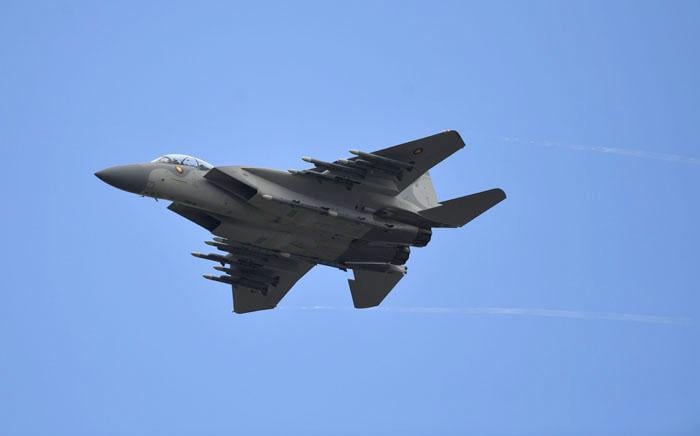
A Qatari Air Force Boeing F-15QA carrying 12 CATM-120s, unarmed training versions of Raytheon’s AIM-120 missile, flies July 21 at the Farnborough Airshow.
FARNBOROUGH—Raytheon hopes sustained, high demand for the AIM-120 Amraam both domestically and abroad will drive the U.S. government to reconsider a multiyear procurement strategy for the missile after Congress declined to do so last year.
Based on its extensive use in Ukraine with the National Advanced Surface-to-Air Missile System (Nasams) and a push by militaries to rethink stock levels, Raytheon plans to maximize production of the AIM-120 at 1,200 per year for the foreseeable future. That is according to Paul Ferraro, Raytheon’s president of air and space defense systems, speaking at the Farnborough Airshow here.
That level is more than double what it was just a few years ago, when RTX’s defense business saw uneven demand of 450 missiles one year and 600 the next, Ferraro says. Unstable demand largely meant multiyear procurement was not effective, but the planned rate of 1,200 without an end in sight might change that approach.
In its fiscal 2024 budget request, the U.S. Air Force wanted the multiyear authority for Amraam, along with the Joint Air-to-Surface Standoff Missile (JASSM) and the Long-Range Anti-Surface Missile (LRASM). The latter two requests were approved, but Congress kept Amraam as a single-year procurement item.
The Air Force manages foreign military sales of Amraam, including those that have been sent to Ukraine. The missile has been integrated on 14 platforms to date.
Ferraro argues the multiyear plan would help the company with stability among its suppliers, allowing it to bundle purchases of components and buy larger quantities of materials.
Raytheon started at Lot 36 of the missile building at a rate of 1,160 per year, with Lot 38 rising to 1,200. The company is building just two variants now: the AIM-120C8, which Nasams largely uses; and the air-launched AIM-120D3.
The company is still developing a new extended-range version for air launch, using the D3 front end with a larger rocket motor. This has been designed specifically for the internal bays of the F-35 and F-22. This is an internally developed program with no customers yet coming forward with an intent to buy.
Raytheon also plans to dramatically increase production of its AIM-9X missile but needs to find another supplier to help it get there.
The company is moving from a production rate of 1,400 per year to 2,500 per year by the next production lot, which is largely linked to increased uses in Nasams and the U.S. Army’s Indirect Fire Protection Capability. Barbara Borgonovi, president of Naval Power at Raytheon, said July 23 that the company is looking for a third supplier of rocket motors within the U.S. to meet this demand.
It is evaluating multiple candidates, looking to replicate the European partnerships it already has with Avio in Italy and Nammo in Norway that previously helped increase capacity. Forming a new partnership in the U.S. like those will take years to ensure the supplier is qualified for the critical component of the missile, Borgonovi says.
